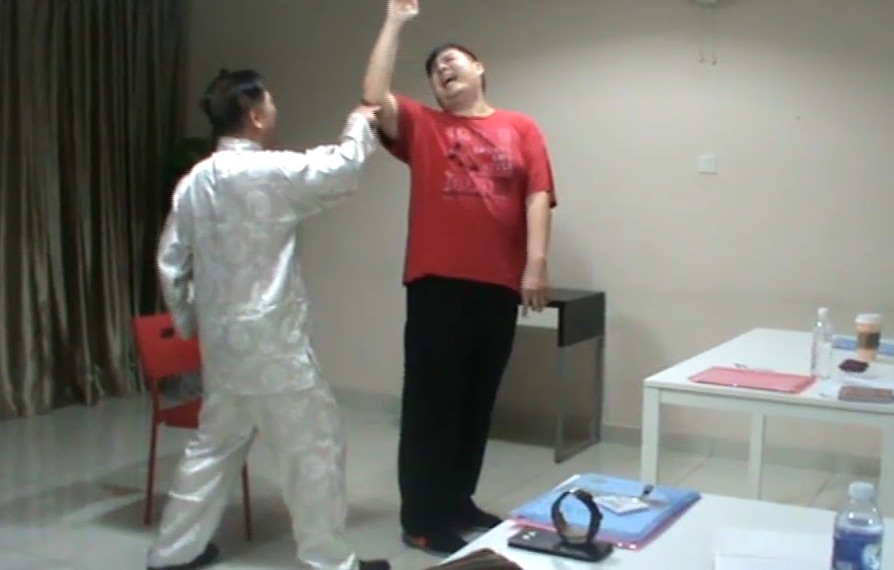CHI KUNG TO OVERCOME PAIN

Big Wind Mill
Question
Despite the improvement with my knees and energy, I still have difficulty moving my arm past shoulder height without pain. I am concerned that it could hamper both my academic and martial studies.
You have recommended “Lifting the Sky” as an exercise for clearing away blockages caused by injuries. In this case, I have a little trouble raising my left arm beyond shoulder's height without considerable pain. I've seen doctors and physiotherapists and am doing some remedial exercises. Other than “Zheng Gu Shui” and lots of rest, what would you recommend I do to treat the shoulder?
-- Leong, Australia
Answer
Conventional doctors and physiotherapists may give you some temporary relieve, but will not be able to overcome your shoulder pain. It is because yours is an energy disorder, not a physical disorder. Conventional doctors and physiotherapists work at the physical level, energy is still not in their conceptual framework.
Literally “Zheng Gu Shui” means “Correcting-Bone-Solution”. It is a medicinal solution for external injuries. “Gu” here does not refer only to “gu”, or bones, but is a shortened form for “jin, gu, pi”, which are “tendons, bones, flesh”. “Zheng Gu Shui” may help to relieve some pain, but is insufficient to thoroughly overcome your shoulder problem.
As yours is an energy problem, the best therapeutic approach is via chi kung exercises. This is attacking your problem at its roots. “Flowing Breeze and Swaying Willows” described above is excellent for this purpose. “Lifting the Sky” is also excellent, but as you may not be able to lift your arms due to your shoulder injury, it may not be practical. A practical exercise to clear your energy problem at your shoulder is “Big Wind Mill”, which uses a thematic approach to chi flow, in contrast to the holistic approach of “Flowing Breeze and Swaying Willows”.
Before I describe the exercise, I would like to give a brief idea of the traditional Chinese medical concept of injuries.
In traditional Chinese medicine, injuries (shang) are differentiated from illness (bin). The specialized branch of Chinese medicine dealing with injuries is called “shang ke” (pronounced like “shang ker” and not “shang ki”), which I refer to in my book, “The Complete Book of Chinese Medicine”, as “traumatology” or colloquially as “kungfu medicine”.
Injuries are of two main categories, internal injuries and external injuries. Internal injuries are injuries to “jing”, “shen” and “qi”, whereas external injuries are injuries to “jin”, “gu” and “bi”.
Here, “jing” does not refer to “sperm” or “essence”. You probably would have read my explanation of “jing” as “essence” or sub-atomic particles in an earlier issue of my question-answer series. Here “jing” refers to blood and internal organs. (In deeper meaning, it also refers to the “essence” or sub-atomic particles of blood and internal organs.)
“Shen” refers to mind or spirit, and “qi” (“chi”) to energy. Damage to an internal organ, distortion of energy flow, and shattering of a person's spirit are examples of internal injuries.
“Jin”, “gu” and “pi” refer to tendons (and muscles), bones and flesh. Sprained muscles, dislocation of joints, and concussion are examples of external injuries.
The division into internal and external injuries is for convenience. A person is an integrated organism. Even a simple external injury like a bruise has internal implications, and vice visa. A traumatologist, or any Chinese physician, treats a patient as a whole person, not just his injuries or illness.
Basically your shoulder pain is due to an energy blockage caused by your sparring partners. Initially there might be some related minor external injuries like twisted muscles or bruises, but over time these minor injuries have been corrected by application of “Zheng Gu Shui” as well by your own self-curative and regenerative abilities. But the energy blockage remains, thus causing you pain.
You can overcome the problem by practicing “Big Wind Mill” twice or three times a day as follows. Stand upright and relax. Smile from your heart. Lift your injured arm forward and upward in an arc as high as you comfortably can, simultaneously breathing in gently through your nose. Then complete the circle by bringing your arm downward and backward in an arc, simultaneously breathing out loudly but in a gentle manner through your fairly opened mouth. Gently drop your arm at your side and pause for a second or two. Repeat the procedure about 20 times.
For balance, practice the same procedure for the other non-injured arm, but for only half the number of times. Start with the non-injured arm, say for ten times. Then practice for the injured arm for twenty times. At first you may only make a small circle with your injured arm as you have difficulty lifting it high. Gradually increase the height until eventually you can make a full circle without feeling any pain.
After you have performed the “Big Wind Mill” with your injured arm for about twenty times, drop the arm effortlessly on your side, stand upright and be totally relaxed. You will find your chi flowing and your body swaying. This is “Flowing Breeze and Swaying Willows”, and is a crucial part of your healing. You may feel some “good pain” as the chi clears your injury. After some time, think gently of your dan tian, keep still for a short while and complete the session by massaging your face. You can find a description of the “Big Wind Mill” in my book, “Chi Kung for Health and Vitality”.
Leong kindly wrote to Sifu Wong on 18th June as follows. "Thank you so much for your generous advice. My shoulder is almost fully recovered after doing the Big Windmill and especially Flowing Breeze Swaying Willows." Sifu Wong's advice was given to Leong in March.
LINKS
Courses and Classes
